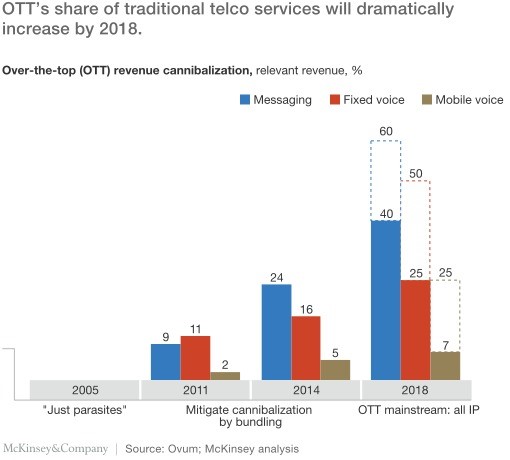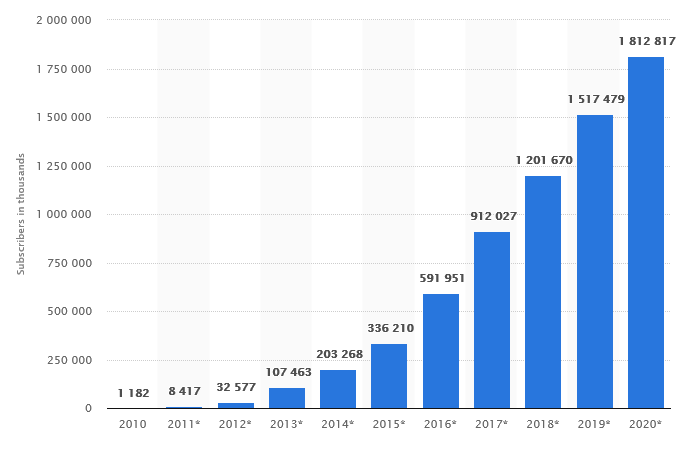The Onslaught of OTT

Experts say that Year 2010 was the highest point for the SMS industry, with an estimated 3.5 billion active users (source: wiki). At that time, about 80 percent of all mobile subscribers largely depended upon the traditional messaging service provided by telecom operators.
The following years saw a rapid development in internet-based communication, accompanied by the adoption of smartphones. With the advent of compatible operating systems like Android and iOS, mobile-based apps became the preferable platform for instant messaging rather than web-based real-time communication.
The new development caused unprecedented changes mostly affecting the P2P messaging sector. Traditional SMS operated by Telco took a backseat with increasing users favoring OTT-enabled messaging apps.
The Data Talks
A report from the previous year by Ovum has estimated that the telecommunications industry will lose a combined $386 billion between 2012 and 2018 from customers using OTT voice applications (Source: New Telegraph). The report also shows that over 150 million users have dropped out of subscriptions.
This is attributed to the increased availability of internet platforms that consumers use over affordable data schemes facilitated by LTE networks. Many of them are switching over to data-based solutions for most forms of communication including messaging and VoIP.

OTT Share of traditional telco services will dramatically increase by 2018 | Source: McKinsey & Company
Trying to Reverse the Onslaught
As we can see that the telecom industry is currently dominated by major OTT players who are cannibalizing across various services like messaging, voice calls, pay TV, videos, etc. On the other hand, operators have been struggling since the rapid adoption of the internet. Presently, machine learning; AI, cloud computing, etc. are further assisting the intuitiveness of OTT applications, facilitating a more personalized experience for their users.
Some telecom operators are redefining their strategies and business models to adapt to a data-driven ecosystem. For example, numerous operators in Africa like Airtel, Cell-C, Safaricom, etc. are diversifying their services into new revenue streams like mobile money, media, insurance, e-commerce, etc. (Source: Gadget South Africa).
While the progression of 4G LTE has been accelerated the usage of data-intensive OTT applications, it has also been a significant enabler for operators. LTE-based operators are acquiring more and more users by offering HD quality voice calls and high-speed data bundles.
Owing to their extensive subscriber base, 4G operators have an excellent premise to build relevant data-based solutions for their subscribers. Considering that they have significant access to an extensive customer database and analytics, operators can harness them to develop intuitive services for the users.

Number of 4G mobile subscribers worldwide from 2010 to 2020 (in 1,000) | Source: Statista
Experimenting with Hybrid-OTT Apps
Data has become the linchpin of today’s telecom and digital landscape. This is further accelerated by the rise of LTE technology which is pushing telecom towards new growth zones.
Now is the time for telecom operators to work towards a Hybrid-OTT app that can deliver services from the cloud over data, as well as over multiple carrier networks. Operators can leverage upon their voice calling capabilities, over which they have optimal control.
Therefore, WiFi enabled calls are a promising ground for network operators who can tap significant revenue opportunities. They can offer robust voice communication by combining the best of GSM and data. When voice traffic travels over data or WiFi, new use cases and flexibility are generated for the users, which bring the power of internet into their hands.
Enabling a Virtualized, SIM-independent calling experience
It is also an opportunity for carriers to offer seamless calling and messaging that provides the customizable user experience of OTT apps but also interconnects into their network functions. Thus, a user can receive voice calls and SMS to any of their mobile number(s) over data, and also make outbound calls and send SMS over data, to any number, from any of their mobile number(s).
GSM-VoIP Call Conversion
The proliferation of data elicits a generation of OTT apps that partially address the communication challenges of mobile users. On the other hand, hybrid OTT approach, with telco and internet connectivity, can result in a unique suite of app-based solutions that mobile operators can roll out to their subscribers. Inspired by the idea of virtualization of numbers, GSM-VoIP call conversions, and visual voicemails, we can focus on technologies and innovations that define the next generation telecom experience.
To sum up, amidst the stiff competition and challenges posed by cloud-based OTT apps, telecom operators still have the time to carve out their niche. This can only begin by re-imagining ‘voice communication’ in a data era, which combines the best of GSM and VoIP.
A distinct hybrid-OTT approach is the way to go forward. It can also enable mobile operators to capture the ‘otherwise missed revenue’ from the calling party, and work towards increasing brand loyalty.







